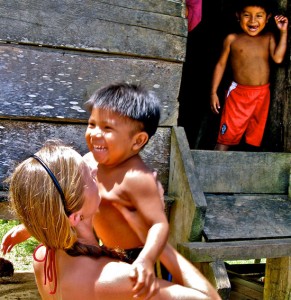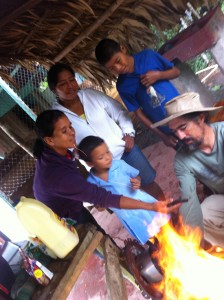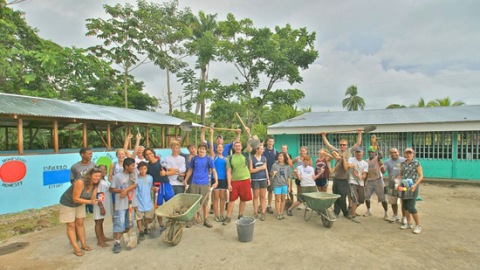Spring break provides an incredible opportunity to do some volunteer work and have a vacation too. A key is ensuring that any community service projects you are interested in are actually sustainable, ongoing efforts into which the local community is fully invested. Otherwise, the effort is a one-off, short-term feel-good experience for the traveler with minimal enduring positive local impact and possibly even negative local net effect.
 Some have called the fusion of service and a vacation voluntourism, but I prefer the term eco-immersion. Eco-immersion embeds the service component and other elements of your experience in a thoughtful, 360-degree context which enhances the entire journey so that you didn’t just do a service project or see some cool stuff in a foreign land, but rather were given pause about what is most important to you — even back home! This approach re-connects you with yourself and those close to you by giving to others in need while learning in a hands-on way about many other aspects of their life and the world they live in. The payback is dramatic.
Some have called the fusion of service and a vacation voluntourism, but I prefer the term eco-immersion. Eco-immersion embeds the service component and other elements of your experience in a thoughtful, 360-degree context which enhances the entire journey so that you didn’t just do a service project or see some cool stuff in a foreign land, but rather were given pause about what is most important to you — even back home! This approach re-connects you with yourself and those close to you by giving to others in need while learning in a hands-on way about many other aspects of their life and the world they live in. The payback is dramatic.
Eco-immersion as a family experience is a profound opportunity for learning, fun and precious, quality time spent together, unplugged, sharing and instilling important values. Such an experience together is, as they say, priceless. Of course as a student group, you would be hard-pressed to maximize your spring break in a more meaningful yet fun and rewarding way!
Giving Back
One of the strongest collaborators I have personally had the pleasure of working with — a man committed to running such sustainable, locally invested projects — is Arturo Segura. He is a renowned organic coffee wizard, humanitarian and innovator, who works with travelers to install clean burning eco-stoves in indigenous villages across Costa Rica. These efforts directly reduce respiratory illness, a major health issue facing wood-burning indigenous populations worldwide. Furthermore, these simple but efficient devices dramatically reduce the amount of wood consumed, saving resources and lowering carbon dioxide production.
Travelers get to work with and know Arturo, whose own story is phenomenal. (He left his Dad’s traditional coffee farm go completely wild 25 years ago to the astonishment of his neighbors, who thought he had gone “loco.” Now his shade grown, forest nurtured coffee is internationally recognized!) Visitors also gain a deep understanding of local villagers. Meanwhile, all this takes place in locations of sublime natural beauty and biodiversity and there are plenty of local kids who love sharing their amazing lifestyle and environment with the curious! Such experiences have profound effects on the way travelers view themselves and others as they develop a more nuanced and deeper global perspective.
There are a multitude of ways travelers can engage in community projects while on vacation. Many people enjoy  working with rural schools on projects, including classroom construction, mural installation and educational organic garden planting. The greatest part about these experiences is the enduring effect it has on the traveler, no matter the age! To give you an example, we work with an incredible school in Weston, Mass. called Meadowbrook that sends their eighth graders on such an eco-immersion community service trip to Costa Rica. This culminating experience plays an integral role in the curriculum throughout the year.
working with rural schools on projects, including classroom construction, mural installation and educational organic garden planting. The greatest part about these experiences is the enduring effect it has on the traveler, no matter the age! To give you an example, we work with an incredible school in Weston, Mass. called Meadowbrook that sends their eighth graders on such an eco-immersion community service trip to Costa Rica. This culminating experience plays an integral role in the curriculum throughout the year.
Recently, two 13-year-old students were so moved by their experience — tutoring the local population and assisting at an orphanage in Limon — that they returned home with a mission to start a fundraising campaign and work with their teachers to develop a tutoring program. Through hard work and sheer perseverance these young leaders were able to raise more than $3,500 for the cause while organizing a return trip to Costa Rica!
When the students touched down in Costa Rica, their goals were two-fold: help educate local students in mathematics and donate the supplies they collected to the orphanage. This experience included hands-on, step-by-step instruction in using a manipulative program developed at Harvard that uses scale-sized blocks called Digiblocks to allow students to see and feel what their math algorithms actually represent.
For the next several days, the same teachers and students partnered with local educators in classrooms to co-teach and support this initiative. The trip culminated in the students delivering the donations to the orphanage, which totaled 10 large duffle bags and included clothes, shoes, toys and books. There were actually more boxes that could not be delivered in person due to bag limitations on the plane, so they continued to ship donations from back home! These kids were only eighth graders, but through voluntourism, or better yet, eco-immersion, their eyes were opened to a world of new possibilities! These kinds of life-changing experiences are what fuel my passion for experiential travel.
Each of these opportunities is in a special place and the folks you will meet are extremely engaging. This is the essence of eco-immersion. Once you connect with committed people, doing good work sustainably in a magical part of the planet, it is actually easy to achieve the best balance of service, adventure, education and unwinding that does the trick for you. Such volunteer experiences are truly lasting in effect and somehow manage to energize, enlighten and relax those willing to strive for something beyond a vacation!
By: Crawford HillEducator, CEO of Chill Expeditions Huffington Post

